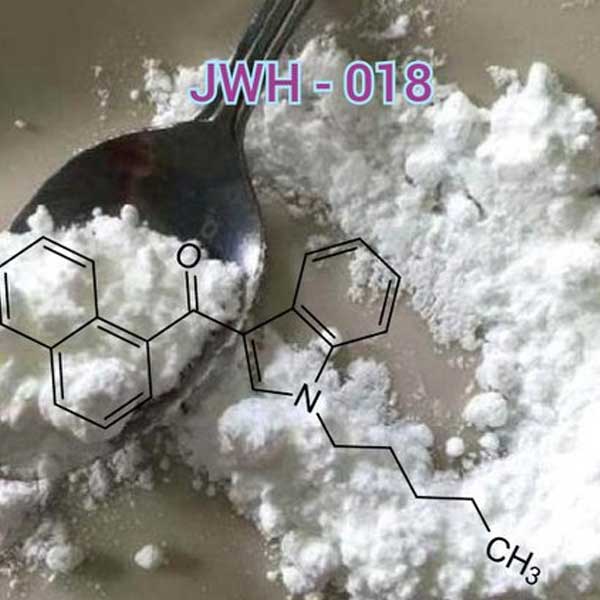
JWH-018 is an analgesic chemical from the naphthoylindole family that acts as a full agonist at both the CB₁ and CB₂ cannabinoid receptors, with some selectivity for CB₂.
JWH-018 (1-pentyl-3-(1-naphthoyl)indole, NA-PIMO[3] or AM-678) is an analgesic chemical from the naphthoylindole family that acts as a full agonist at both the CB1 and CB2 cannabinoid receptors, with some selectivity for CB2. It produces effects in animals similar to those of tetrahydrocannabinol (THC), a cannabinoid naturally present in cannabis, leading to its use as synthetic cannabinoid products that, in some countries, are sold legally as “incense blends”. Learn more
As a full agonist at both the CB1 and CB2 cannabinoid receptors, this chemical compound is classified as an analgesic medication.The analgesic effects of cannabinoid ligands, mediated by CB1 receptors are well established in treatment of neuropathic pain, as well as cancer pain and arthritis.
These compounds work by mimicking the body’s naturally-produced endocannabinoid hormones such as 2-AG and anandamide (AEA), which are biologically active and can exacerbate or inhibit nerve signaling.[10] As the cause is poorly understood in chronic pain states, more research and development must be done before the therapeutic potential of this class of biologic compounds can be realized.[10]
Former times
John W. Huffman, an organic chemist at Clemson University, synthesized a variety of chemical compounds that affect the endocannabinoid system. JWH-018 is one of these compounds, with studies showing an affinity for the cannabinoid CB1 receptor five times greater than that of THC.
On 15 December 2008, it was reported by German pharmaceutical companies that JWH-018 was found as one of the active components in at least three versions of the grey market drug Spice, which has been sold as an incense in a number of countries around the world since 2006. An analysis of samples acquired four weeks after the German prohibition of JWH-018 took place found that the manufacturers had shortened the alkyl chain by one carbon to circumvent the ban.
JWH-018 is a full agonist of both the CB1 and CB2 cannabinoid receptors, with a reported binding affinity of 9.00 ± 5.00 nM at CB1 and 2.94 ± 2.65 nM at CB2. JWH-018 has an EC50 of 102 nM for human CB1 receptors, and 133 nM for human CB2 receptors. JWH-018 produces bradycardia and hypothermia in rats at doses of 0.3–3 mg/kg, suggesting potent cannabinoid-like activity.
Pharmacokinetics
Metabolism of JWH-018 was assessed using Wistar rats which had been administered an ethanolic extract containing JWH-018. Urine was collected for 24 hours, followed by extraction of JWH-018 metabolites using both liquid-liquid extraction and solid-phase extraction. GC-MS was utilized to separate and identify the extracted compounds. JWH-018 and its N-dealkylated metabolite were only detected in small amounts, with hydroxylated N-dealkylated metabolites comprising the primary signal. The observed mass shift indicates that it is likely that hydroxylation occurs in both the naphthalene and indole portions of the molecule. Human metabolites were similar although most metabolism took place on the indole ring and pentyl side chain, and the hydroxylated metabolites were extensively conjugated with glucuronide. When inhaled, the median half-life of JWH-018 is 1.69 hours.
use
At least one case of JWH-018 dependence has been reported by the media. The user consumed JWH-018 daily for eight months. Withdrawal symptoms were more severe than those experienced as a result of cannabis dependence. JWH-018 has been shown to cause profound changes in CB1 receptor density following administration, causing desensitization to its effects more rapidly than related cannabinoids.
On 15 October 2011, Anderson County coroner Greg Shore attributed the death of a South Carolina college basketball player to “drug toxicity and organ failure” caused by JWH-018. A November 2011 email concerning the case was released in December 2011 under the Freedom of Information Act after multiple requests to see the information had been denied.
Compared to THC, which is a partial agonist at CB1 receptors, JWH-018, and many synthetic cannabinoids, are full agonists. JWH-018 may cause intense anxiety, agitation, and in rare cases, has been assumed to have been the cause of seizures and convulsions. JWH-018 and analogs of it may present serious dangers to the user when used to excess.
Various physical and psychological adverse effects have been reported from JWH-018 use. One study reported psychotic relapses and anxiety symptoms in well-treated patients with mental illness following JWH-018 inhalation.[23] Due to concerns about the potential of JWH-018 and other synthetic cannabinoids to cause psychosis in vulnerable individuals, it has been recommended that people with risk factors for psychotic disorders, such as a past or family history of psychosis, not use these substances.
Drug class
Legal status
- AU: S9 (Prohibited substance)
- BR: Class F2 (Prohibited psychotropics)
- CA: Schedule II, In general uncontrolled could be illegal to sell for human consumption or the analogue acts in several countries.
- DE: Anlage II (Authorized trade only, not prescriptible)
- UK: Class B
- US: Schedule I
- UN: Psychotropic Schedule II